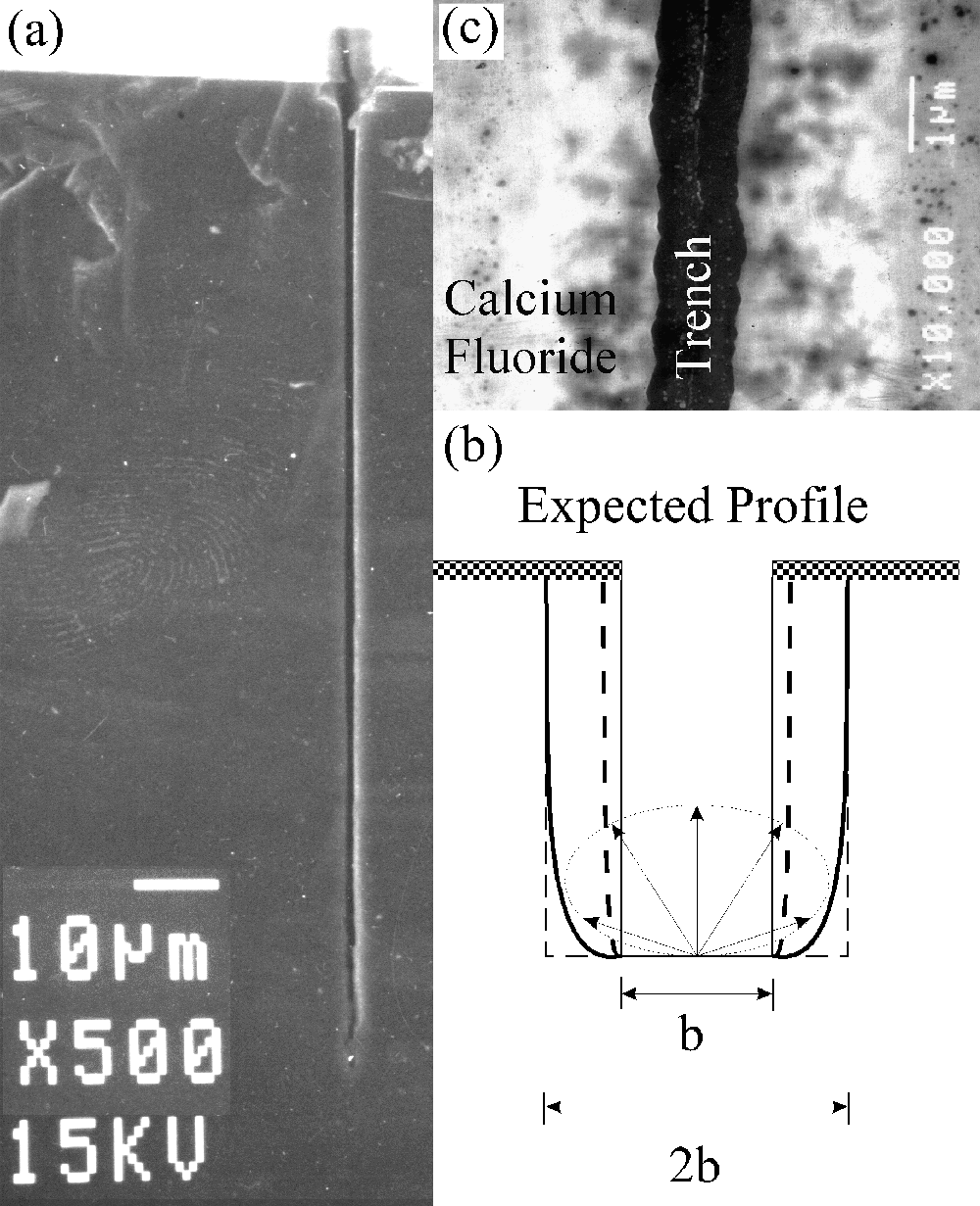 Fig. 3 High Aspect Ratio Trenches.
Fig. 3 High Aspect Ratio Trenches.
(a) Cross-sectional SEM view of a 1 mm wide, 120 mm-deep, CaF2-masked trench in Si(100). The trench was fluorine etched for 100 minutes at a substrate temperature of 500oC. (b) Shows a plot of the expected profile assuming a cosine distribution for reactive species scattered at the bottom of the trench with the solid (dotted) line for full (20%) reactivity. (c) Shows a top view of the trench and the CaF2 mask, as labeled. Note the pinholes in the CaF2 mask.
(See discussion below.)
To investigate the anisotropic nature of etching Si with our atomic fluorine beam, CaF2 was used as an etch resistant mask. For the CaF2-masked Si(100) substrates, 1 mm-wide slots were opened in molecular-beam-epitaxially grown 20 nm-thick CaF2 layers using electron-beam lithography following the procedure of Hirose et al.4. In this case, a standard scanning electron microscope (SEM) with a 20 keV, 1 nA electron beam was used to write lines with a dose of 2.5 Ccm-2. CaF2 under direct electron-beam exposure dissociates leaving Ca, which oxidizes in air. The resist layer is then developed in water (CaO is 100 times more soluble in water than CaF2) leaving 1 mm-wide openings to the underlying silicon. Figure 3(a) shows a cross-sectional SEM view of a 1 mm-wide, 120 mm-deep trench in Si(100) fabricated by etching for 100 minutes with TSUB=500oC. This trench is extremely anisotropic, with an aspect ratio of about 120:1 and a sidewall slope of about 1000:1 over nearly the entire depth. These aspect ratios and sidewall slopes are comparable or higher than those currently achievable by reactive ion etching.5,6 Another notable feature is that the 1.2 mm/min etch rate observed for the trench is within 20% of the open-area etch rate of 1.0 mm /min at 500oC (Fig. 2(b)). Since this is comparable to the run-to-run error of our experiments (see above), we conclude that our atomic beam does not exhibit aspect-ratio dependent etching (ARDE), even for this high aspect-ratio geometry.
Discussion of Trench Results
For a collimated neutral beam, undercutting results from reactive species scattering within the trench and then striking and etching the sidewalls. For our pressure regime and geometry, gas phase interactions within the trench are not important. Only reactive species scattered from the trench bottom will contribute to sidewall etching. Given the relatively low efficiency of etching (7% at 500oC), it is expected that there is substantial backscattered atomic fluorine. The solid curve in Fig. 3 (b) is a trench profile calculated by assuming that the reactivity of backscattered fluorine is undiminished from that of fluorine incident upon the bottom of the trench. This profile shows a trench twice as wide as the mask opening with substantial curvature at the trench bottom. The dotted profile, calculated by assuming reduced reactivity of the scattered species by a factor of five, still shows widening, again with curvature at the bottom. This form of sidewall curvature is absent in our trenches. We do see etching of the sidewall at the top of the trench within about 3 mm of the mask, but this is clearly not of the form expected from scattered reactive species. In fact, the top feature appears to be the result of fluorine atoms that pass through pinholes in the CaF2 mask near the trench opening and etch the Si. These pinholes are shown in the SEM micrograph Fig. 3(c).
The lack of sidewall etching observed in our trench is both qualitatively and quantitatively different from that observed by Giapis et al., who use atomic F with much higher incident kinetic energies.2,7. Interestingly, we see much less sidewall etching even though our etch rate indicates a lower fluorine reaction efficiency. This implies that the large number of F atoms scattering from the bottom do not significantly etch the sidewalls in our case.
In order for atomic F to contribute to sidewall etching, the fluorine atoms incoming from the highly collimated beam must first strike the trench bottom, since the role of gas-gas collisions in the trench is negligible. Even partial energy accommodation with the surface will then deprive most of these F atoms of a considerable fraction of their incident 1 eV kinetic energy, so that subsequent collisions with the sidewall will occur with much lower kinetic energy and at very large incident angles. Both these conditions would reduce sidewall etching efficiency. Thus, from kinetic energy arguments alone, one would expect diffusively scattered fluorine to etch at a much slower rate than the atomic fluorine incident at 1 eV directly from the beam. Indeed, the magnitude of this variance in etch rates can by itself explain the sort of anisotropy we observe.
 Fig. 3 High Aspect Ratio Trenches.
Fig. 3 High Aspect Ratio Trenches.